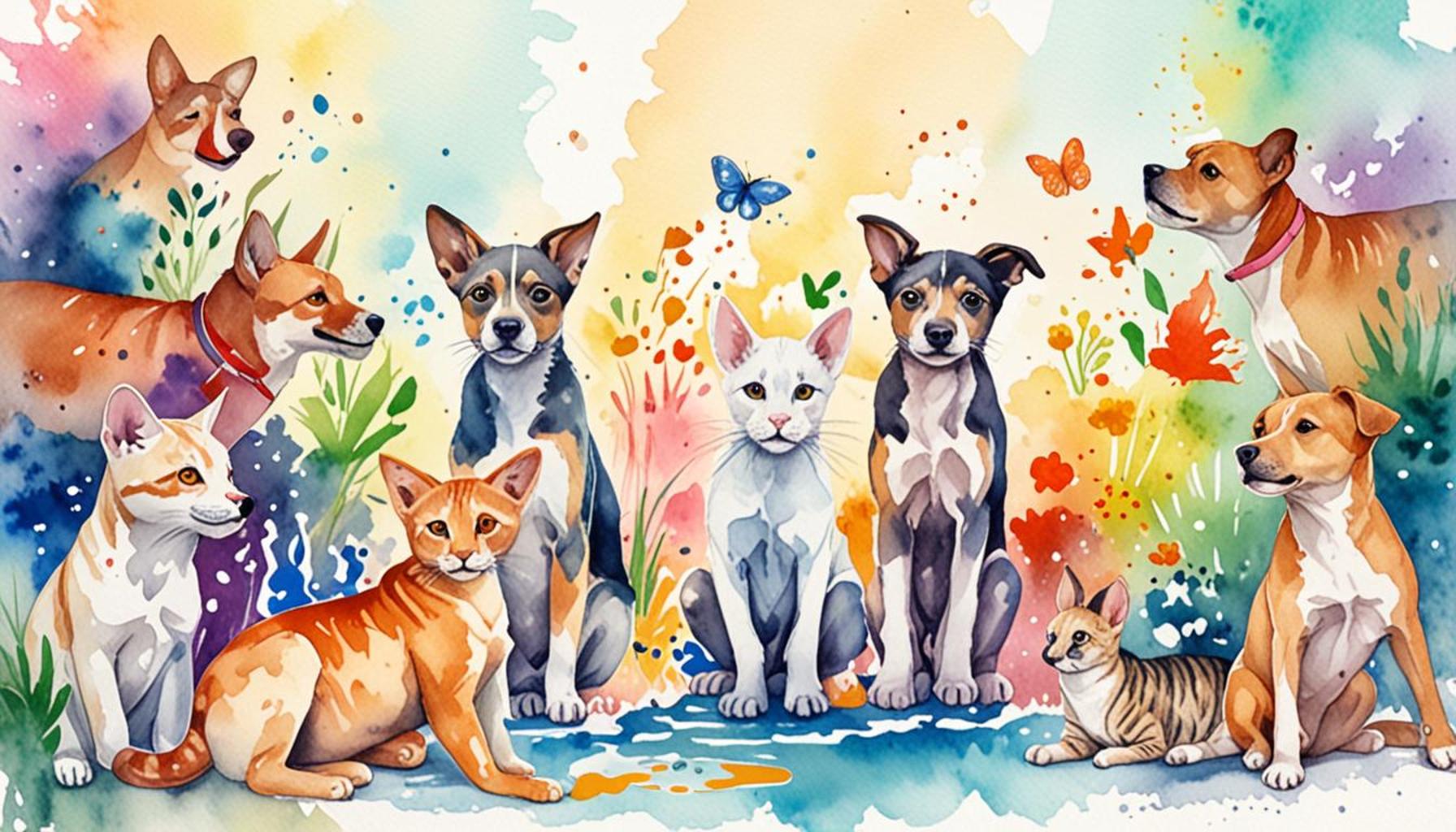The Impact of Volunteering on the Animal Adoption Process: How Helping Can Make a Difference

The Indispensable Role of Volunteers in Animal Shelters
The impact of volunteers in animal shelters cannot be overstated. These dedicated individuals often serve as the backbone of these organizations, providing essential services that help enhance the chances of successful adoptions. By transforming the lives of countless pets and potential adopters, volunteers create a ripple effect that benefits the entire community.
One of the most significant contributions made by volunteers is the socialization of animals. Animals in shelters often experience stress due to the sudden change in their environment, which can lead to behavioral issues that make them less adoptable. Volunteers spend countless hours interacting with these animals, teaching them basic commands, helping them with leash training, and exposing them to a variety of stimuli. This not only makes the animals more manageable but also endears them to prospective adopters. A study conducted by the ASPCA found that animals who receive regular socialization are over 60% more likely to be adopted than those who do not.
Another critical role of volunteers is assisting with the adoption process. Volunteers often serve as the face of the organization, providing personalized insights about each animal’s temperament and needs. Their firsthand experiences with the pets allow them to guide potential adopters in making informed choices. For instance, a volunteer who has spent time with a particular dog can speak to its energy level, suitability for families, or compatibility with other pets—information that is invaluable to potential adopters looking for a perfect match.
Additionally, volunteers play a pivotal role in organizing adoption events and outreach programs. These events not only draw attention to the animals in need of homes but also educate the community about responsible pet ownership. Oftentimes, volunteers coordinate partnerships with local businesses to sponsor pet adoption days, flea markets, or other fundraising activities. Such events can significantly raise awareness and contribute to increased adoption rates. For example, the “Clear the Shelters” initiative, celebrated across the United States, showcases the power of community involvement, with volunteers leading the charge to ensure it’s a success.
Ultimately, the work of volunteers leads to a more favorable environment for animals awaiting homes. By engaging in consistent human interaction, these dedicated individuals help improve the well-being of shelter pets, thus making them more appealing to potential adopters. Their efforts also play an essential role in shaping community attitudes towards adoption, highlighting the importance of giving a second chance to rescued animals.

In conclusion, volunteering at animal shelters is not just about saving animals; it’s about creating a more compassionate society. As communities continue to face challenges related to pet overpopulation, the efforts of volunteers become increasingly vital. Their contributions not only enrich the lives of shelter animals but also foster lasting change that reverberates throughout the community, encouraging more families to consider adoption as a loving option for expanding their households.
DISCOVER MORE: Click here to find out how social media shapes pet supply choices
Enhancing Animal Welfare Through Volunteer Commitment
The direct involvement of volunteers in animal shelters significantly elevates the quality of care provided to animals awaiting adoption. It’s a delicate balance of nurturing, education, and advocacy, which together spearhead a transformative approach to animal welfare. Volunteers often take on multifaceted roles, each contributing uniquely to the efficiency and effectiveness of the adoption process.
One of the most profound impacts of volunteering is seen in the area of behavioral rehabilitation. Many animals arrive at shelters with backgrounds that may include neglect, abuse, or abandonment. Such experiences can lead to anxiety or fearfulness, often making these animals harder to adopt. Volunteers work diligently to instill trust and confidence in these animals through consistent and gentle interaction. Programs that incorporate volunteer-led training can lead to a remarkable recovery in a pet’s behavior, paving the way for a more positive adoption experience. According to the Animal Shelter Association, behavioral improvement dramatically increases an animal’s prospects for finding a forever home.
Moreover, the educational role of volunteers cannot be overlooked. Many volunteers share their knowledge not only with potential adopters but also within the wider community, advocating for responsible pet ownership. By providing insights into the importance of spaying and neutering, proper training methods, and understanding pet behavioral cues, volunteers create a more informed population of pet owners. When communities are educated, adoption rates often soar as individuals become more prepared to welcome an animal into their homes. In fact, a recent survey found that areas with proactive educational programs saw a 35% increase in adoptions over three years.
Volunteers also often take the initiative to foster animals temporarily. This process provides a much-needed break from the shelter environment and enables pets to adjust to a home setting, which can reduce anxiety and improve social skills. Foster volunteers play a crucial role in assessing an animal’s compatibility with different types of households—whether they are suited for families with children or homes with other pets. Their testimonies and assessments are invaluable for shelters looking to make informed matches between animals and potential adopters. Many animal shelters have reported that animals who have undergone foster care are adopted at rates of nearly 50% higher than those who haven’t.
It is also essential to highlight how volunteers contribute to enhancing the visibility of animals awaiting adoption through social media and outreach initiatives. Many shelters now depend on social media platforms to showcase their pets, share their stories, and promote adoption events. Volunteers often take the photographs and write engaging narratives that highlight an animal’s personality and quirks, enticing followers to consider adoption. Resulting engagement leads to increased foot traffic at shelters and potential adoptions. Statistics show that shelters utilizing social media effectively see an average increase of 25% in adoption inquiries.
In essence, the unified efforts of volunteers not only provide immediate support to animals in need but also shape a robust framework for community engagement in the adoption process. By enhancing animal welfare, transforming public perceptions, and galvanizing greater communal participation, these dedicated individuals are instrumental in making a lasting difference in animal adoption.
| Advantage | Description |
|---|---|
| Increased Visibility for Shelters | Volunteering helps shelters gain public awareness, attracting potential adopters through community outreach and promotional events. |
| Enhanced Animal Care | Dedicated volunteers improve the quality of life for animals, making them more adoptable with better socialization and training. |
The adoption process for animals often hinges on various factors that can either facilitate or hinder the transition from rescue to forever home. When volunteers engage with animal shelters, they not only provide much-needed labor but also contribute to the overall experience and care that potential adopters encounter. Through increased visibility, volunteers can help the community understand the joy of adopting pets, thus increasing the chances of finding loving homes for animals in need. Enhanced animal care, provided through voluntary efforts, ensures that adoptable pets are showcased in their best light, ultimately driving more successful adoptions. Exploring these themes reveals the profound impact that helping others can have on the lives of animals and their future families.
DON’T MISS: Click here to discover essential nutrition tips
Creating Lifelong Connections: The Role of Volunteers in Promotion and Community Engagement
Beyond the immediate support volunteers offer to animals directly within shelters, their role in fostering community connections and spreading awareness about adoption cannot be overstated. Volunteers act as ambassadors for their local animal shelters, participating in community events and outreach initiatives that promote animal welfare and responsible pet ownership. By engaging the community, they not only raise awareness about animals available for adoption but also cultivate a culture of compassion and commitment towards animal welfare.
One vital aspect of this outreach is the organization of adoption events. Volunteers often take the lead in planning and executing these events, which are designed to create a fun and festive atmosphere while connecting animals with potential adopters. These events range from pop-up adoptions at local parks to participation in community fairs and festivals. According to the American Society for the Prevention of Cruelty to Animals (ASPCA), shelters that regularly conduct adoption events see a significant uptick in adoptions and community interest. Community-focused events encourage interaction, allowing potential adopters to meet animals in a relaxed environment, fostering emotional connections and encouraging on-the-spot decision-making. In essence, these volunteer-led initiatives serve as a bridge between community members and the animals in need of homes.
In addition, the incorporation of storytelling and pet profiles plays a critical role in the successful adoption process. Volunteers often craft compelling narratives about the animals in their care, highlighting their unique characteristics and backgrounds. These profiles, when paired with engaging photographs, serve to capture the hearts of potential adopters. Effective storytelling taps into the emotional aspect of adopting a pet, transforming a mere transaction into a heartfelt connection. Research has shown that animal profiles with engaging stories can influence adoption decisions, particularly among those who may feel hesitant about adopting.
Another significant contribution that volunteers make is their involvement in partnerships with local businesses. These collaborations can lead to greater visibility for shelters and enhance community support for adoption initiatives. For instance, some shelters partner with pet-friendly cafes or stores to host adoption drives or awareness campaigns. They utilize these platforms to create mutually beneficial arrangements, offering businesses an opportunity to showcase their support for animal welfare while directing attention to the adoptable pets. As a result, both the animals and the community benefit from the synergy created within these partnerships.
Volunteers also play a pivotal role in gathering and analyzing data regarding the adoption process, helping shelters identify trends and areas for improvement. By tracking metrics such as adoption rates, return rates, and community engagement, volunteers can contribute valuable insights that inform shelter policies and practices. This data-driven approach not only helps refine the strategies employed in the adoption process but also enhances the overall welfare and management of the shelter. Knowledge-sharing meetings among volunteers can result in tangible improvements to service delivery, ensuring that lessons learned positively impact future adoptees.
The commitment and creativity of volunteers resonate throughout the entire community, leading to a ripple effect that plays a crucial role in changing perceptions about shelter animals. As they share their experiences, families and friends are inspired to consider adopting a pet themselves, further amplifying the message of compassion and care. Within such an environment where volunteering is embraced, the collective impact on animal adoption becomes profound. In the end, both volunteers and the animals they serve benefit from the meaningful connections formed through these efforts, ultimately leading to more successful adoptions and a brighter future for our furry companions.
DISCOVER MORE: Click here to learn about the future of pet diets
Conclusion: Embracing the Power of Volunteerism in Animal Adoption
The landscape of animal adoption is profoundly shaped by the dedicated efforts of volunteers who orchestrate meaningful connections between pets and potential adopters. As we have explored, the influence of volunteering extends far beyond the immediate care provided to the animals in shelters. By organizing community events, crafting engaging pet profiles and stories, and partnering with local businesses, volunteers break down barriers that often prevent animals from finding loving homes. Their unwavering commitment not only enhances the visibility of shelter animals but also fosters a culture of compassion within the community.
The statistical evidence underscores this connection; shelters that leverage volunteer-led initiatives witness significant increases in adoption rates. Moreover, the use of data analysis empowers shelters to refine their strategies, leading to more effective outreach and improved animal welfare. As volunteers share their experiences and insights, they build a network of advocates that inspires others to consider adoption as a viable and rewarding option. This ripple effect amplifies the message of responsible pet ownership and promotes a compassionate community spirit.
In conclusion, volunteering is not merely an act of service; it is a transformative force in the animal adoption process. As individuals step forward to lend their time and talents, they contribute to a greater movement that changes lives—both of the animals in need and the families that welcome them into their homes. By supporting volunteer efforts, we all play a role in making a lasting difference in the lives of countless animals. As the call for compassion resonates, let us embrace the opportunity to make our communities more inclusive for all, one adoption at a time.


